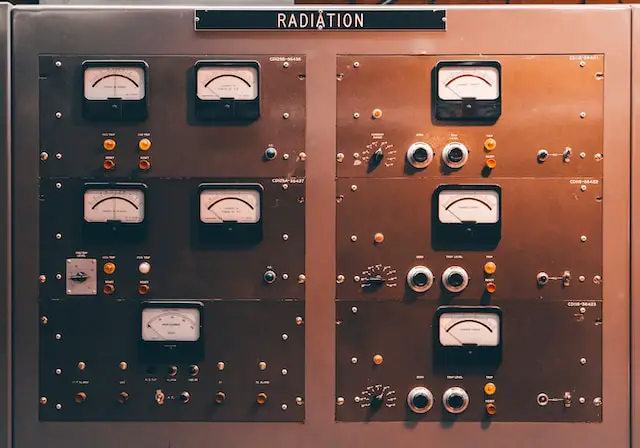Both elements are radioactive, but their uses differ greatly in terms of nuclear energy production. Thorium has a higher critical mass than uranium, meaning that it is more efficient in producing power. Uranium is used predominantly for weapons-grade material, whereas thorium can be used to create fuel which would produce less waste and cause less radiation damage compared to conventional methods.
Thorium
Thorium is an element with the atomic number 90. It is a naturally-occurring, slightly radioactive metal found in small quantities on Earth. Thorium is not fissile, meaning it cannot sustain a nuclear chain reaction without being bombarded by neutrons from an outside source. However, thorium can be used to breed fuel fornuclear reactors. When thorium is bombarded by neutrons, it produces uranium-233, which is fissile.
Uranium
(Photo by Dan Meyers on Unsplash )

Uranium is a radioactive element with the symbol U and atomic number 92. It is a silvery-white metal in the actinide series of metals. Uranium is used as fuel for nuclear reactors and as a material for nuclear weapons.
Thorium Vs. Uranium – Key differences
Thorium and uranium are both radioactive elements that can be used as fuel in nuclear reactors, but there are several key differences between them:
Abundance: Thorium is much more abundant in the Earth’s crust than uranium. While uranium is relatively scarce, thorium is more common than lead.
Radioactivity: Uranium is a highly radioactive element that can undergo nuclear fission, releasing a large amount of energy. Thorium, on the other hand, is a less radioactive element that requires a neutron source to undergo fission.
Reactor design: Nuclear reactors that use uranium typically require complex cooling systems to prevent overheating and potential meltdowns. Reactors that use thorium, on the other hand, can operate at higher temperatures and may require simpler cooling systems.
Waste: Nuclear reactors that use uranium generate large amounts of radioactive waste that can remain hazardous for thousands of years. Thorium reactors produce less long-lived waste and can potentially use existing nuclear waste as fuel.
Weapons proliferation: Uranium can be used to create nuclear weapons, whereas thorium cannot be easily weaponized.
Thorium is considered by some to be a promising alternative to uranium for nuclear power generation, due to its abundance, lower radioactivity, and potentially lower waste output. However, there are still many technical and economic challenges to be addressed before thorium-based reactors can become commercially viable.
Is thorium better than uranium?
Uranium is the most commonly used fuel for nuclear reactors, but there is growing interest in thorium as an alternative. Proponents of thorium argue that it has several advantages over uranium, including a lower risk of proliferation, a higher energy density, and improved safety characteristics. However, thorium also has some disadvantages, including a more complex fuel cycle and the need for more expensive infrastructure. Ultimately, the decision of whether to use thorium or uranium will depend on specific reactor designs and objectives.
Why don’t we use thorium instead of uranium?
There are a few reasons why we don’t use thorium instead of uranium. First, thorium is much less abundant than uranium. This means that it would be more expensive to produce, and there wouldn’t be as much available to use. Second, thorium is more difficult to enrich than uranium. Enriching uranium is already a complicated and expensive process, so using thorium would make it even more so. Finally, thorium reactors are not yet as developed as uranium reactors. Uranium reactors have been in use for many years, while thorium reactors are still in the early stages of development.
Is thorium more expensive than uranium?
Thorium is generally considered to be cheaper than uranium, both in terms of the cost of the raw material and the cost of operating a nuclear reactor. This is due to several factors:
Abundance: As mentioned earlier, thorium is more abundant in the Earth’s crust than uranium. This means that the cost of mining and refining thorium is generally lower than that of uranium.
Fuel efficiency: Thorium is more efficient than uranium at producing energy in a nuclear reactor. This means that less thorium is needed to generate the same amount of electricity, resulting in lower fuel costs.
Waste: Nuclear reactors that use thorium generate less long-lived radioactive waste than reactors that use uranium. This means that the cost of storing and disposing of nuclear waste is lower for thorium-based reactors.
Safety: Thorium reactors are generally considered to be safer than uranium reactors, due to their lower risk of meltdowns and other accidents. This can help to reduce the cost of nuclear power by lowering insurance premiums and other costs associated with nuclear accidents.
While there are still many technical and economic challenges to be addressed before thorium-based reactors can become widely adopted, thorium is generally considered to be a promising alternative to uranium for nuclear power generation, due in part to its lower cost.
What is powerful than uranium?
Plutonium is generally considered to be more powerful than uranium in terms of its potential use in nuclear weapons and its radioactive properties. Plutonium is a radioactive element that can be produced by irradiating uranium in a nuclear reactor or a nuclear bomb. It is highly toxic and can remain radioactive for thousands of years, making it a serious health hazard if not handled properly. Plutonium has been used in nuclear weapons and in the production of nuclear energy, but its use is highly regulated due to the risks associated with its production and handling.
Is it safe to touch uranium?
No, it is not safe to touch uranium. While natural uranium is relatively harmless because it is not very soluble and its radioactivity is low, enriched uranium is much more dangerous. Enriched uranium is what is used in nuclear weapons and reactors, and it is much more radioactive than natural uranium. It can also be more easily dissolved in water, so if you were to come into contact with it, you could end up with a very high dose of radiation.
What is thorium and uranium used for?
Thorium and uranium are both radioactive elements that can be used in a variety of applications, including nuclear power generation and nuclear weapons.
Uranium is primarily used as fuel in nuclear reactors, where it undergoes a process called fission to produce heat, which is then used to generate electricity. Uranium can also be enriched to increase its concentration of the isotope uranium-235, which is necessary for nuclear weapons.
Thorium, on the other hand, has several potential uses in nuclear power generation. Thorium can be used as fuel in a type of nuclear reactor called a molten salt reactor, which is designed to be more efficient and safer than traditional nuclear reactors. Thorium can also be used to breed the isotope uranium-233, which can be used as fuel in nuclear reactors or in nuclear weapons.
In addition to their use in nuclear power generation and weapons, both thorium and uranium have other applications. Uranium has been used in the production of ceramic glazes and in the manufacture of high-strength alloys for use in the aerospace industry. Thorium has been used as a heat-resistant material in gas mantles for lamps, as well as in welding electrodes and in the production of specialty glass.
It’s worth noting that both thorium and uranium are highly radioactive and can be dangerous if not handled properly. The use of these elements in nuclear applications is highly regulated and requires strict safety measures to prevent accidents and minimize the risk of exposure to radiation.
Featured Image By – Markus Distelrath from Pixabay









